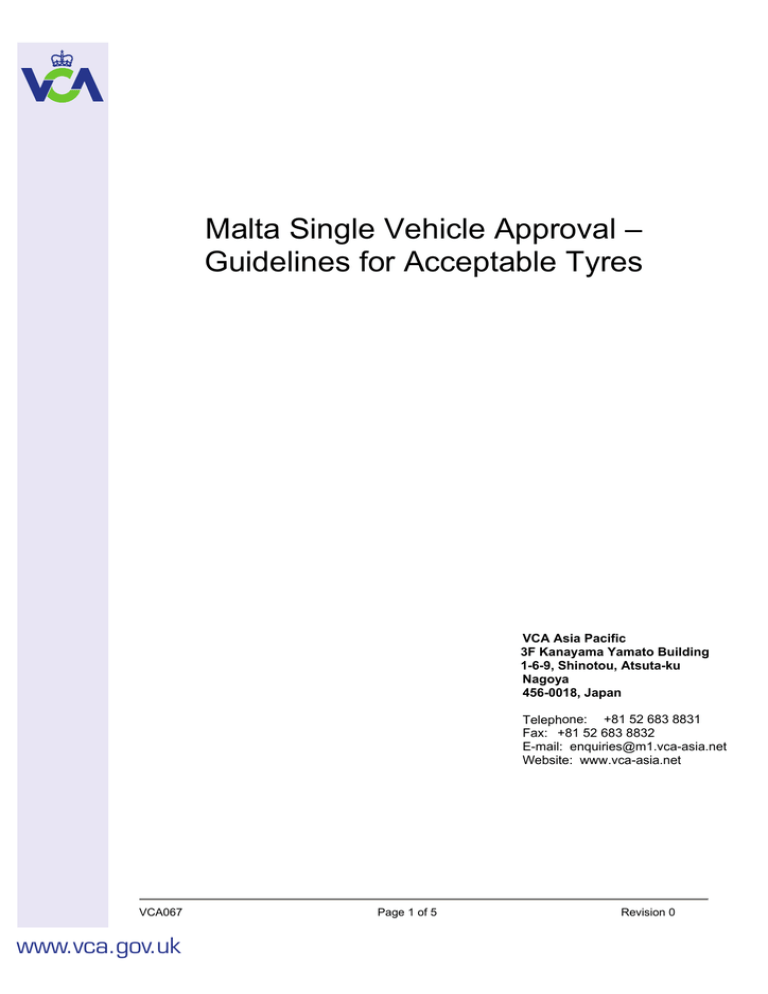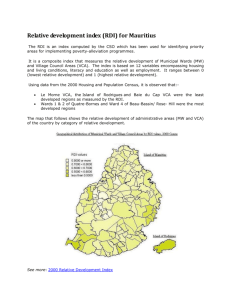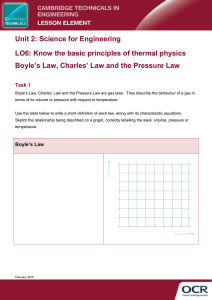Malta Single Vehicle Approval – Guidelines for Acceptable Tyres
advertisement

Malta Single Vehicle Approval – Guidelines for Acceptable Tyres VCA Asia Pacific 3F Kanayama Yamato Building 1-6-9, Shinotou, Atsuta-ku Nagoya 456-0018, Japan Telephone: +81 52 683 8831 Fax: +81 52 683 8832 E-mail: enquiries@m1.vca-asia.net Website: www.vca-asia.net VCA067 www.vca.gov.uk Page 1 of 5 Revision 0 Malta Single Vehicle Approval – Guidelines for Acceptable Tyres Tyres are required to have two marks in total: 1) 2) An acceptable approval mark. Tyre load capacity and safe speed capability markings. Examples are given below: 1) Tyres must be marked with at least ONE of the following three acceptable approval marks: Japanese Industry Standard EU Approval Mark - ‘E4’ VCA067 www.vca.gov.uk Page 2 of 5 Revision 0 American Approval (FMVSS 109) & Canadian Approval (CMVSS) FMVS Approval, shown as: DOT XXXX XXX XXX on the tyre, where X = a number or letter and the last three will be the Date of Manufacture 2) Tyres are ALSO required to display safe load and speed markings. Background by way of example: 82 = an index representing the safe load the tyre can carry S = an index representing the safe speed that the tyre is capable of, therefore the faster the car – the higher the letter must be. VCA067 www.vca.gov.uk Page 3 of 5 Revision 0 Examples of Markings Load Marking Safe Load per axle Speed Marking 78 79 82 95 1700 kg 1748 kg 1900 kg 2760 kg Q S H V Safe Max. Speed 160 km/h 180 km/h 210 km/h 240 km/h Inspection Priority List for Tyre Markings Regarding acceptable tyre markings, in order of importance, #1 being most important, VCA uses the following guidelines: 1. Tyre information on manufacturer’s sticker, usually found on a vehicle’s B-pillar. 2. Tyre information from the vehicle’s handbook, usually found in the glove compartment 3. Tyre information listed in the Model Test Report. Therefore, if a valid manufacturer’s sticker is found on a vehicle, VCA will first review this sticker to compare its information against the tyres mounted to a given vehicle. If no sticker is found, VCA will then look for tyre information in the vehicle’s handbook. If no marking information is found in the handbook, VCA will use the appropriate Model Test Report. Tyres are required to be of an appropriate width: VCA reviews each tyre fitted to the vehicle and looks for tyre size information. An example of such information is as follows: VCA067 www.vca.gov.uk Page 4 of 5 Revision 0 Regarding acceptable tyre widths, in order of importance, #1 being most important, VCA uses the following guidelines: 1. Tyre information on manufacturer’s sticker, usually found on a vehicle’s B-pillar. 2. Tyre information from the vehicle’s handbook, usually found in the glove compartment 3. Tyre information listed in the Model Test Report. Therefore, if a valid manufacturer’s sticker is found on a vehicle, VCA will first review this sticker to compare its information against the tyres mounted to a given vehicle. If no sticker is found, VCA will then look for tyre information in the vehicle’s handbook. If no marking information is found in the handbook, VCA will use the appropriate Model Test Report However, if there is a question about the appropriateness of the tyres’ width, VCA uses the following methodology to make its decision: Tyres fitted to a vehicle must not extend beyond the vehicle’s bodywork. Please see the following drawing: VCA checks the span of 30o towards the FRONT of the vehicle, marked “A”, to 50o towards the REAR of the vehicle, marked “C”. If the tyre is inside the vehicle’s body work in the span from A to C, then the tyre’s width is deemed to be appropriate. VCA067 www.vca.gov.uk Page 5 of 5 Revision 0



